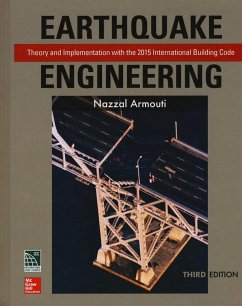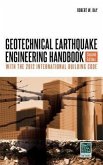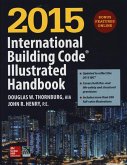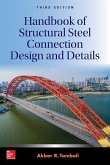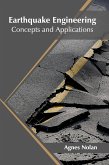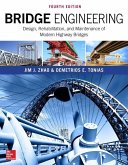Nazzal Armouti
Earthquake Engineering: Theory and Implementation with the 2015 International Building Code, Third Edition
Nazzal Armouti
Earthquake Engineering: Theory and Implementation with the 2015 International Building Code, Third Edition
- Gebundenes Buch
- Merkliste
- Auf die Merkliste
- Bewerten Bewerten
- Teilen
- Produkt teilen
- Produkterinnerung
- Produkterinnerung
Publisher's Note: Products purchased from Third Party sellers are not guaranteed by the publisher for quality, authenticity, or access to any online entitlements included with the product. Fully updated coverage of earthquake-resistant engineering techniques, regulations, and codes This thoroughly revised resource offers cost-effective earthquake engineering methods and practical instruction on underlying structural dynamics concepts. Earthquake Engineering, Third Edition, teaches how to analyze the behavior of structures under seismic excitation and features up-to-date details on the design…mehr
Andere Kunden interessierten sich auch für
![Geotechnical Earthquake Engineering, Second Edition Geotechnical Earthquake Engineering, Second Edition]() Robert W DayGeotechnical Earthquake Engineering, Second Edition163,99 €
Robert W DayGeotechnical Earthquake Engineering, Second Edition163,99 €![2015 International Building Code Illustrated Handbook 2015 International Building Code Illustrated Handbook]() International Code Council2015 International Building Code Illustrated Handbook144,99 €
International Code Council2015 International Building Code Illustrated Handbook144,99 €![Handbook of Structural Steel Connection Design and Details, Third Edition Handbook of Structural Steel Connection Design and Details, Third Edition]() Akbar R TamboliHandbook of Structural Steel Connection Design and Details, Third Edition208,99 €
Akbar R TamboliHandbook of Structural Steel Connection Design and Details, Third Edition208,99 €![Earthquake Engineering: Concepts and Applications Earthquake Engineering: Concepts and Applications]() Earthquake Engineering: Concepts and Applications148,99 €
Earthquake Engineering: Concepts and Applications148,99 €![Bridge Engineering: Design, Rehabilitation, and Maintenance of Modern Highway Bridges, Fourth Edition Bridge Engineering: Design, Rehabilitation, and Maintenance of Modern Highway Bridges, Fourth Edition]() Jim J ZhaoBridge Engineering: Design, Rehabilitation, and Maintenance of Modern Highway Bridges, Fourth Edition208,99 €
Jim J ZhaoBridge Engineering: Design, Rehabilitation, and Maintenance of Modern Highway Bridges, Fourth Edition208,99 €![Open Channel Hydraulics, Third Edition Open Channel Hydraulics, Third Edition]() Terry W SturmOpen Channel Hydraulics, Third Edition166,99 €
Terry W SturmOpen Channel Hydraulics, Third Edition166,99 €![Seismic Resistant Design and Technology Seismic Resistant Design and Technology]() Dentcho IvanovSeismic Resistant Design and Technology202,99 €
Dentcho IvanovSeismic Resistant Design and Technology202,99 €-
-
-
Publisher's Note: Products purchased from Third Party sellers are not guaranteed by the publisher for quality, authenticity, or access to any online entitlements included with the product. Fully updated coverage of earthquake-resistant engineering techniques, regulations, and codes This thoroughly revised resource offers cost-effective earthquake engineering methods and practical instruction on underlying structural dynamics concepts. Earthquake Engineering, Third Edition, teaches how to analyze the behavior of structures under seismic excitation and features up-to-date details on the design and construction of earthquake-resistant steel and reinforced concrete buildings, bridges, and isolated systems. All applicable requirements are fully explained-including the 2015 International Building Code and the latest ACI, AISC, and AASHTO codes and regulations. Advanced chapters cover seismic isolation, synthetic earthquakes, foundation design, and geotechnical aspects such as liquefaction. Earthquake Engineering, Third Edition, covers: * Characteristics of earthquakes * Linear elastic dynamic analysis * Nonlinear and inelastic dynamic analysis * Behavior of structures under seismic excitation * Design of earthquake-resistant buildings (IBC) * Seismic provisions of reinforced concrete structures (ACI code) * Introduction to seismic provisions of steel structures (AISC code) * Design of earthquake-resistant bridges (AASHTO code) * Geotechnical aspects and foundations * Synthetic earthquakes * Introduction to seismic isolation
Hinweis: Dieser Artikel kann nur an eine deutsche Lieferadresse ausgeliefert werden.
Hinweis: Dieser Artikel kann nur an eine deutsche Lieferadresse ausgeliefert werden.
Produktdetails
- Produktdetails
- Verlag: McGraw Hill LLC
- 3rd Revised edition
- Seitenzahl: 544
- Erscheinungstermin: 23. Juli 2015
- Englisch
- Abmessung: 235mm x 191mm x 30mm
- Gewicht: 1139g
- ISBN-13: 9781259587122
- ISBN-10: 1259587126
- Artikelnr.: 43485539
- Herstellerkennzeichnung
- Libri GmbH
- Europaallee 1
- 36244 Bad Hersfeld
- gpsr@libri.de
- Verlag: McGraw Hill LLC
- 3rd Revised edition
- Seitenzahl: 544
- Erscheinungstermin: 23. Juli 2015
- Englisch
- Abmessung: 235mm x 191mm x 30mm
- Gewicht: 1139g
- ISBN-13: 9781259587122
- ISBN-10: 1259587126
- Artikelnr.: 43485539
- Herstellerkennzeichnung
- Libri GmbH
- Europaallee 1
- 36244 Bad Hersfeld
- gpsr@libri.de
1 Introduction 2 Characteristics of Earthquakes 2.1 Causes of Earthquakes 2.2 Plate Tectonic Theory 2.3 Measures of Earthquakes 2.3.1 Magnitude 2.3.2 Intensity 2.3.3 Instrumental Scale 2.3.4 Fourier Amplitude Spectrum 2.3.5 Power Spectral Density 2.3.6 Response Spectrum 3 Linear Elastic Dynamic Analysis 3.1 Introduction 3.2 Single Degree of Freedom System 3.2.1 System Formulation 3.2.2 Response Spectrum of Elastic Systems 3.2.3 Design Response Spectrum 3.3 Generalized Single Degree of Freedom 3.4 Multiple Degrees of Freedom System 3.4.1 Multiple Degrees of Freedom System in 2D Analysis Modal Analysis Orthogonality of Mode Shapes Caution Importance of Modes 3.4.2 Multiple Degrees of Freedom System in 3D Analysis Combination Effect of Different Ground Motions 3.4.3 Mass Participation in Buildings 3.5 Shear Beam 3.6 Cantilever Flexure Beam Comparison between Shear Beam and Cantilever Flexure Beam 3.7 Simple Flexure Beam 3.8 Axial Beam 3.9 Finite Element Method 3.9.1 Finite Element Concept in Structural Engineering 3.9.2 Stiffness Matrix (Virtual Work Approach) 3.9.3 Mass Matrix (Virtual Work Approach) 3.9.4 Stiffness and Mass Matrices (Galerkin Approach) 3.9.5 Other Matrices 3.9.6 Mass Matrix in 2D 3.9.7 Application of Consistent Mass Matrix 3.10 Incoherence 3.11 Problems 4 Nonlinear and Inelastic Dynamic Analysis 4.1 Introduction 4.2 Single Degree of Freedom System 4.3 Numerical Methods 4.3.1 Central Differences Method 4.3.2 Newmark-ß Methods 4.3.3 Wilson-
Method 4.4 Multiple Degrees of Freedom System 4.5 Equivalent Linearization 4.6 Problems 5 Behavior of Structures under Seismic Excitation 5.1 Introduction 5.1.1 Force-Reduction Factor, R 5.1.2 Ductility 5.1.3 Energy Dissipation Capacity 5.1.4 Self-Centering Capacity 5.1.5 Frequency Shift General Note 5.2 Relationship between Force Reduction and Ductility Demand 5.2.1 Equal Displacement Criterion 5.2.2 Equal Energy Criterion 5.2.3 General Relationship between R and µd 5.3 Relationship between Global Ductility and Local Ductility 5.4 Local Ductility Capacity 5.5 Evaluation of Monotonic Local Ductility Capacity 5.5.1 Monotonic Behavior of Concrete 5.5.2 Monotonic Behavior of Steel 5.5.3 Idealized Strain Compatibility Analysis Curvature at First Yield Curvature at Ultimate State 5.5.4 General Strain Compatibility Analysis 5.6 Evaluation of Cyclic Local Ductility Capacity 5.6.1 Cyclic Behavior of Concrete 5.6.2 Cyclic Behavior of Steel 5.6.3 Cyclic Strain Compatibility Analysis 5.7 Precast Concrete Structures 5.8 Effect of Structure Configuration on Ductility 5.9 Second-Order Effect on Ductility 5.10 Undesirable Hysteretic Behavior Undesirable Hysteretic Behavior Due to Material Deterioration Undesirable Hysteretic Behavior Due to Unfavorable Structural Configuration 5.11 Effect of Axial Load on Hysteretic Behavior 5.11.1 Rigid Bar Idealization Case 1: Rigid Bar under Axial Load and without Springs Case 2: Rigid Bar with Springs and without Axial Load Case 3: Rigid Bar with Springs and under Axial Load 5.11.2 Energy Dissipation Factor (aN) 5.12 Design Considerations 5.13 Capacity Design 5.14 Pushover Analysis 5.15 Recommended versus Undesirable Structural Systems 5.16 Strain Rate 5.17 Problems 6 Design of Earthquake-Resistant Buildings (IBC) 6.1 Introduction 6.2 Definition of Structural Components 6.2.1 Seismic Base 6.3 Seismic Design Category 6.4 Zoning Classification 6.5 Response Spectra 6.6 Design Requirements of Seismic Design Categories Seismic Design Category A Seismic Design Category B and C Seismic Design Category D, E, and F 6.7 Earthquake-Induced Forces 6.7.1 Regularity of Structures Horizontal Types of Irregularity Vertical Types of Irregularity 6.7.2 Simplified Lateral Force Analysis Procedure Vertical Distribution of Base Shear 6.7.3 Equivalent Lateral Force Procedure Vertical Distribution of Base Shear 6.7.4 Modal Response Spectrum Analysis 6.7.5 Two-Stage Analysis Procedures 6.7.6 Time-History Analysis 6.7.7 Directional Effect Redundancy Factor (
) 6.8 Load Combinations 6.9 Definitions and Requirements of Structural Systems 6.10 Special Topics 6.10.1 Diaphragm Design Forces 6.10.2 Torsional Effect 6.10.3 Drift Limitations 6.10.4 Structural Separation 6.10.5 P-
Effect 6.11 Problems APPENDIX 6-1 7 Seismic Provisions of Reinforced Concrete Structures (ACI 318) 7.1 Introduction 7.2 Ordinary Moment Frames 7.2.1 Ordinary Beams Main Reinforcement Development of Reinforcement Shear Reinforcement 7.2.2 Ordinary Beam-Columns Main Reinforcement Development of Reinforcement Shear Reinforcement 7.3 Intermediate Moment Frames 7.3.1 Intermediate Beams Main Reinforcement Lateral Reinforcement 7.3.2 Intermediate Beam-Columns Lateral Reinforcement 7.4 Special Moment Frames 7.4.1 Special Beams Design Shear, Ve Dimension Limitations Main Reinforcement Lateral Reinforcement 7.4.2 Special Beam-Columns Design Forces Dimension Limitations Main Reinforcement Lateral Reinforcement Details Minimum Lateral Reinforcement Concrete Cover Protection 7.4.3 Special Joints Development of Reinforcement Confined Concrete 7.5 Ordinary Shear Walls Force Requirements Reinforcement Requirements 7.6 Special Shear Walls 7.6.1 Special Shear Walls without Openings Force Requirements Reinforcement Requirements Boundary Element Requirements Detailing of Boundary Elements 7.6.2 Special Shear Walls with Openings 7.7 Coupling Beams 7.7.1 Detailing of Coupling Beams with Diagonals Diagonals Coupling Beams 7.8 Diaphragms and Trusses 7.8.1 Structural System 7.8.2 Shear Strength 7.8.3 Diaphragm Chords and Truss Members 7.9 Foundations 7.9.1 Strength Requirements 7.9.2 Detailing Requirements 7.10 Precast Concrete 7.10.1 Precast Special Moment Frames Precast Special Frames with Ductile Connections Precast Special Frames with Strong Connections 7.10.2 Precast Intermediate Shear Walls 7.10.3 Precast Special Shear Walls 7.11 Nonseismic-Resisting Systems 7.11.1 General Requirements (A) Beam Requirements Beam-Column Requirements 7.11.2 General Requirements (B) Rectangular Sections Circular and Spiral Sections APPENDIX 7-1 8 Introduction to AISC Seismic Provisions for Structural Steel Buildings 8.1 Introduction 8.2 General Requirements Load Combinations Material Demand Critical Welds Slenderness Requirements Special Bracing at Plastic Hinge Locations Protected Zones Column Splices 8.3 Structural Systems 8.3.1 Ordinary Moment Frames FR Moment Connections Demand Critical Welds Regions 8.3.2 Intermediate Moment Frames Slenderness of Beams Protected Zones Beam-to-Column Connections Demand Critical Welds Regions 8.3.3 Special Moment Frames Column-Beam Moment Ratios Slenderness of Beams Protected Zones Beam-to-Column Connections Lateral Support of Column Flanges Demand Critical Welds Regions 8.3.4 Special Truss Moment Frames Dimension Limitations Special Segments Slenderness of Special Segments Protected Zones Bracing of Trusses Demand Critical Welds Regions 8.3.5 Ordinary Cantilever Column Systems Demand Critical Welds Regions 8.3.6 Special Cantilever Column Systems Slenderness of Columns Protected Zones Base Plate Demand Critical Welds Regions 8.3.7 Ordinary Concentrically Braced Frames Slenderness of Columns V-braced and Inverted V-braced Frames Diagonal Brace Connections Demand Critical Welds Regions 8.3.8 Special Concentrically Braced Frames Slenderness of Columns Protected Zones Strength Requirements Beam-to-Column Connections Brace Connections Diagonal Braces V- and Inverted V-Type Braces Demand Critical Welds Regions 8.3.9 Eccentrically Braced Frames Strength Requirements Slenderness Requirements Protected Zones Beam-to-Column Connections General Link Requirements Demand Critical Welds Regions 8.3.10 Buckling-Restrained Braced Frames 8.3.11 Special Plate Shear Walls (SPSW) Strength Requirements Slenderness Requirements Protected Zones Demand Critical Welds Regions 8.4 Allowable Stress Design Approach APPENDIX 8-1 9 Design of Earthquake-Resistant Bridges (AASHTO Code) 9.1 Introduction 9.2 AASHTO Procedures for Bridge Design 9.3 Response Spectra 9.4 Single Span Bridges 9.5 Bridges in Seismic Zone 1 9.6 Bridges in Seismic Zone 2 9.7 Bridges in Seismic Zones 3 and 4 9.8 Methods of Analysis 9.8.1 Uniform Load Method Continuous Bridges Discontinuous Bridges 9.8.2 Single-Mode Spectral Method Continuous Bridges Sinusoidal Method for Continuous Bridges Discontinuous Bridges Rigid Deck Method for Discontinuous Bridges 9.8.3 Multiple Mode Spectral Method 9.8.4 Time-History Method 9.8.5 Directional Effect 9.9 Load Combinations 9.10 Design Requirements 9.11 Design Requirements of Reinforced Concrete Beam-Columns 9.11.1 Bridges in Seismic Zone 1 9.11.2 Bridges in Seismic Zone 2 9.11.3 Bridges in Seismic Zones 3 and 4 Detailing of Transverse Reinforcement 9.12 Design Requirements of Reinforced Concrete Pier Walls 9.13 Special Topics 9.13.1 P-
Requirements 9.1 3.2 Displacement Requirements (Seismic Seats) 9.13.3 Longitudinal Restrainers 9.13.4 Hold-Down Devices 9.13.5 Liquefaction APPENDIX 9-1 10 Geotechnical Aspects and Foundations 10.1 Introduction 10.2 Wave Propagation 10.3 Ground Response 10.4 Liquefaction Equivalent Uniform Cyclic Shear Stress Method 10.5 Slope Stability 10.6 Lateral Earth Pressure 10.7 Foundations APPENDIX 10-1 11 Synthetic Earthquakes 11.1 Introduction 11.2 Fourier Transform 11.3 Power Spectral Density 11.4 Stationary Random Processes 11.5 Random Ground Motion Model 11.6 Implementation of Ground Motion Model 11.7 Validity of Synthetic Earthquakes 12 Seismic Isolation 12.1 Introduction 12.2 Concept of Seismic Isolation 12.3 Lead-Rubber Bearing Isolators 12.4 Analysis of Seismically Isolated Structures 12.5 Design of Seismically Isolated Structures Allowable Compressive Stress Allowable Shear Deformation (Shear Strain) Allowable Rotation Stability Requirements Lead Core Dimensions Shear Stiffness APPENDIX 12-1 Bibliography Index
Method 4.4 Multiple Degrees of Freedom System 4.5 Equivalent Linearization 4.6 Problems 5 Behavior of Structures under Seismic Excitation 5.1 Introduction 5.1.1 Force-Reduction Factor, R 5.1.2 Ductility 5.1.3 Energy Dissipation Capacity 5.1.4 Self-Centering Capacity 5.1.5 Frequency Shift General Note 5.2 Relationship between Force Reduction and Ductility Demand 5.2.1 Equal Displacement Criterion 5.2.2 Equal Energy Criterion 5.2.3 General Relationship between R and µd 5.3 Relationship between Global Ductility and Local Ductility 5.4 Local Ductility Capacity 5.5 Evaluation of Monotonic Local Ductility Capacity 5.5.1 Monotonic Behavior of Concrete 5.5.2 Monotonic Behavior of Steel 5.5.3 Idealized Strain Compatibility Analysis Curvature at First Yield Curvature at Ultimate State 5.5.4 General Strain Compatibility Analysis 5.6 Evaluation of Cyclic Local Ductility Capacity 5.6.1 Cyclic Behavior of Concrete 5.6.2 Cyclic Behavior of Steel 5.6.3 Cyclic Strain Compatibility Analysis 5.7 Precast Concrete Structures 5.8 Effect of Structure Configuration on Ductility 5.9 Second-Order Effect on Ductility 5.10 Undesirable Hysteretic Behavior Undesirable Hysteretic Behavior Due to Material Deterioration Undesirable Hysteretic Behavior Due to Unfavorable Structural Configuration 5.11 Effect of Axial Load on Hysteretic Behavior 5.11.1 Rigid Bar Idealization Case 1: Rigid Bar under Axial Load and without Springs Case 2: Rigid Bar with Springs and without Axial Load Case 3: Rigid Bar with Springs and under Axial Load 5.11.2 Energy Dissipation Factor (aN) 5.12 Design Considerations 5.13 Capacity Design 5.14 Pushover Analysis 5.15 Recommended versus Undesirable Structural Systems 5.16 Strain Rate 5.17 Problems 6 Design of Earthquake-Resistant Buildings (IBC) 6.1 Introduction 6.2 Definition of Structural Components 6.2.1 Seismic Base 6.3 Seismic Design Category 6.4 Zoning Classification 6.5 Response Spectra 6.6 Design Requirements of Seismic Design Categories Seismic Design Category A Seismic Design Category B and C Seismic Design Category D, E, and F 6.7 Earthquake-Induced Forces 6.7.1 Regularity of Structures Horizontal Types of Irregularity Vertical Types of Irregularity 6.7.2 Simplified Lateral Force Analysis Procedure Vertical Distribution of Base Shear 6.7.3 Equivalent Lateral Force Procedure Vertical Distribution of Base Shear 6.7.4 Modal Response Spectrum Analysis 6.7.5 Two-Stage Analysis Procedures 6.7.6 Time-History Analysis 6.7.7 Directional Effect Redundancy Factor (
) 6.8 Load Combinations 6.9 Definitions and Requirements of Structural Systems 6.10 Special Topics 6.10.1 Diaphragm Design Forces 6.10.2 Torsional Effect 6.10.3 Drift Limitations 6.10.4 Structural Separation 6.10.5 P-
Effect 6.11 Problems APPENDIX 6-1 7 Seismic Provisions of Reinforced Concrete Structures (ACI 318) 7.1 Introduction 7.2 Ordinary Moment Frames 7.2.1 Ordinary Beams Main Reinforcement Development of Reinforcement Shear Reinforcement 7.2.2 Ordinary Beam-Columns Main Reinforcement Development of Reinforcement Shear Reinforcement 7.3 Intermediate Moment Frames 7.3.1 Intermediate Beams Main Reinforcement Lateral Reinforcement 7.3.2 Intermediate Beam-Columns Lateral Reinforcement 7.4 Special Moment Frames 7.4.1 Special Beams Design Shear, Ve Dimension Limitations Main Reinforcement Lateral Reinforcement 7.4.2 Special Beam-Columns Design Forces Dimension Limitations Main Reinforcement Lateral Reinforcement Details Minimum Lateral Reinforcement Concrete Cover Protection 7.4.3 Special Joints Development of Reinforcement Confined Concrete 7.5 Ordinary Shear Walls Force Requirements Reinforcement Requirements 7.6 Special Shear Walls 7.6.1 Special Shear Walls without Openings Force Requirements Reinforcement Requirements Boundary Element Requirements Detailing of Boundary Elements 7.6.2 Special Shear Walls with Openings 7.7 Coupling Beams 7.7.1 Detailing of Coupling Beams with Diagonals Diagonals Coupling Beams 7.8 Diaphragms and Trusses 7.8.1 Structural System 7.8.2 Shear Strength 7.8.3 Diaphragm Chords and Truss Members 7.9 Foundations 7.9.1 Strength Requirements 7.9.2 Detailing Requirements 7.10 Precast Concrete 7.10.1 Precast Special Moment Frames Precast Special Frames with Ductile Connections Precast Special Frames with Strong Connections 7.10.2 Precast Intermediate Shear Walls 7.10.3 Precast Special Shear Walls 7.11 Nonseismic-Resisting Systems 7.11.1 General Requirements (A) Beam Requirements Beam-Column Requirements 7.11.2 General Requirements (B) Rectangular Sections Circular and Spiral Sections APPENDIX 7-1 8 Introduction to AISC Seismic Provisions for Structural Steel Buildings 8.1 Introduction 8.2 General Requirements Load Combinations Material Demand Critical Welds Slenderness Requirements Special Bracing at Plastic Hinge Locations Protected Zones Column Splices 8.3 Structural Systems 8.3.1 Ordinary Moment Frames FR Moment Connections Demand Critical Welds Regions 8.3.2 Intermediate Moment Frames Slenderness of Beams Protected Zones Beam-to-Column Connections Demand Critical Welds Regions 8.3.3 Special Moment Frames Column-Beam Moment Ratios Slenderness of Beams Protected Zones Beam-to-Column Connections Lateral Support of Column Flanges Demand Critical Welds Regions 8.3.4 Special Truss Moment Frames Dimension Limitations Special Segments Slenderness of Special Segments Protected Zones Bracing of Trusses Demand Critical Welds Regions 8.3.5 Ordinary Cantilever Column Systems Demand Critical Welds Regions 8.3.6 Special Cantilever Column Systems Slenderness of Columns Protected Zones Base Plate Demand Critical Welds Regions 8.3.7 Ordinary Concentrically Braced Frames Slenderness of Columns V-braced and Inverted V-braced Frames Diagonal Brace Connections Demand Critical Welds Regions 8.3.8 Special Concentrically Braced Frames Slenderness of Columns Protected Zones Strength Requirements Beam-to-Column Connections Brace Connections Diagonal Braces V- and Inverted V-Type Braces Demand Critical Welds Regions 8.3.9 Eccentrically Braced Frames Strength Requirements Slenderness Requirements Protected Zones Beam-to-Column Connections General Link Requirements Demand Critical Welds Regions 8.3.10 Buckling-Restrained Braced Frames 8.3.11 Special Plate Shear Walls (SPSW) Strength Requirements Slenderness Requirements Protected Zones Demand Critical Welds Regions 8.4 Allowable Stress Design Approach APPENDIX 8-1 9 Design of Earthquake-Resistant Bridges (AASHTO Code) 9.1 Introduction 9.2 AASHTO Procedures for Bridge Design 9.3 Response Spectra 9.4 Single Span Bridges 9.5 Bridges in Seismic Zone 1 9.6 Bridges in Seismic Zone 2 9.7 Bridges in Seismic Zones 3 and 4 9.8 Methods of Analysis 9.8.1 Uniform Load Method Continuous Bridges Discontinuous Bridges 9.8.2 Single-Mode Spectral Method Continuous Bridges Sinusoidal Method for Continuous Bridges Discontinuous Bridges Rigid Deck Method for Discontinuous Bridges 9.8.3 Multiple Mode Spectral Method 9.8.4 Time-History Method 9.8.5 Directional Effect 9.9 Load Combinations 9.10 Design Requirements 9.11 Design Requirements of Reinforced Concrete Beam-Columns 9.11.1 Bridges in Seismic Zone 1 9.11.2 Bridges in Seismic Zone 2 9.11.3 Bridges in Seismic Zones 3 and 4 Detailing of Transverse Reinforcement 9.12 Design Requirements of Reinforced Concrete Pier Walls 9.13 Special Topics 9.13.1 P-
Requirements 9.1 3.2 Displacement Requirements (Seismic Seats) 9.13.3 Longitudinal Restrainers 9.13.4 Hold-Down Devices 9.13.5 Liquefaction APPENDIX 9-1 10 Geotechnical Aspects and Foundations 10.1 Introduction 10.2 Wave Propagation 10.3 Ground Response 10.4 Liquefaction Equivalent Uniform Cyclic Shear Stress Method 10.5 Slope Stability 10.6 Lateral Earth Pressure 10.7 Foundations APPENDIX 10-1 11 Synthetic Earthquakes 11.1 Introduction 11.2 Fourier Transform 11.3 Power Spectral Density 11.4 Stationary Random Processes 11.5 Random Ground Motion Model 11.6 Implementation of Ground Motion Model 11.7 Validity of Synthetic Earthquakes 12 Seismic Isolation 12.1 Introduction 12.2 Concept of Seismic Isolation 12.3 Lead-Rubber Bearing Isolators 12.4 Analysis of Seismically Isolated Structures 12.5 Design of Seismically Isolated Structures Allowable Compressive Stress Allowable Shear Deformation (Shear Strain) Allowable Rotation Stability Requirements Lead Core Dimensions Shear Stiffness APPENDIX 12-1 Bibliography Index
1 Introduction 2 Characteristics of Earthquakes 2.1 Causes of Earthquakes 2.2 Plate Tectonic Theory 2.3 Measures of Earthquakes 2.3.1 Magnitude 2.3.2 Intensity 2.3.3 Instrumental Scale 2.3.4 Fourier Amplitude Spectrum 2.3.5 Power Spectral Density 2.3.6 Response Spectrum 3 Linear Elastic Dynamic Analysis 3.1 Introduction 3.2 Single Degree of Freedom System 3.2.1 System Formulation 3.2.2 Response Spectrum of Elastic Systems 3.2.3 Design Response Spectrum 3.3 Generalized Single Degree of Freedom 3.4 Multiple Degrees of Freedom System 3.4.1 Multiple Degrees of Freedom System in 2D Analysis Modal Analysis Orthogonality of Mode Shapes Caution Importance of Modes 3.4.2 Multiple Degrees of Freedom System in 3D Analysis Combination Effect of Different Ground Motions 3.4.3 Mass Participation in Buildings 3.5 Shear Beam 3.6 Cantilever Flexure Beam Comparison between Shear Beam and Cantilever Flexure Beam 3.7 Simple Flexure Beam 3.8 Axial Beam 3.9 Finite Element Method 3.9.1 Finite Element Concept in Structural Engineering 3.9.2 Stiffness Matrix (Virtual Work Approach) 3.9.3 Mass Matrix (Virtual Work Approach) 3.9.4 Stiffness and Mass Matrices (Galerkin Approach) 3.9.5 Other Matrices 3.9.6 Mass Matrix in 2D 3.9.7 Application of Consistent Mass Matrix 3.10 Incoherence 3.11 Problems 4 Nonlinear and Inelastic Dynamic Analysis 4.1 Introduction 4.2 Single Degree of Freedom System 4.3 Numerical Methods 4.3.1 Central Differences Method 4.3.2 Newmark-ß Methods 4.3.3 Wilson-
Method 4.4 Multiple Degrees of Freedom System 4.5 Equivalent Linearization 4.6 Problems 5 Behavior of Structures under Seismic Excitation 5.1 Introduction 5.1.1 Force-Reduction Factor, R 5.1.2 Ductility 5.1.3 Energy Dissipation Capacity 5.1.4 Self-Centering Capacity 5.1.5 Frequency Shift General Note 5.2 Relationship between Force Reduction and Ductility Demand 5.2.1 Equal Displacement Criterion 5.2.2 Equal Energy Criterion 5.2.3 General Relationship between R and µd 5.3 Relationship between Global Ductility and Local Ductility 5.4 Local Ductility Capacity 5.5 Evaluation of Monotonic Local Ductility Capacity 5.5.1 Monotonic Behavior of Concrete 5.5.2 Monotonic Behavior of Steel 5.5.3 Idealized Strain Compatibility Analysis Curvature at First Yield Curvature at Ultimate State 5.5.4 General Strain Compatibility Analysis 5.6 Evaluation of Cyclic Local Ductility Capacity 5.6.1 Cyclic Behavior of Concrete 5.6.2 Cyclic Behavior of Steel 5.6.3 Cyclic Strain Compatibility Analysis 5.7 Precast Concrete Structures 5.8 Effect of Structure Configuration on Ductility 5.9 Second-Order Effect on Ductility 5.10 Undesirable Hysteretic Behavior Undesirable Hysteretic Behavior Due to Material Deterioration Undesirable Hysteretic Behavior Due to Unfavorable Structural Configuration 5.11 Effect of Axial Load on Hysteretic Behavior 5.11.1 Rigid Bar Idealization Case 1: Rigid Bar under Axial Load and without Springs Case 2: Rigid Bar with Springs and without Axial Load Case 3: Rigid Bar with Springs and under Axial Load 5.11.2 Energy Dissipation Factor (aN) 5.12 Design Considerations 5.13 Capacity Design 5.14 Pushover Analysis 5.15 Recommended versus Undesirable Structural Systems 5.16 Strain Rate 5.17 Problems 6 Design of Earthquake-Resistant Buildings (IBC) 6.1 Introduction 6.2 Definition of Structural Components 6.2.1 Seismic Base 6.3 Seismic Design Category 6.4 Zoning Classification 6.5 Response Spectra 6.6 Design Requirements of Seismic Design Categories Seismic Design Category A Seismic Design Category B and C Seismic Design Category D, E, and F 6.7 Earthquake-Induced Forces 6.7.1 Regularity of Structures Horizontal Types of Irregularity Vertical Types of Irregularity 6.7.2 Simplified Lateral Force Analysis Procedure Vertical Distribution of Base Shear 6.7.3 Equivalent Lateral Force Procedure Vertical Distribution of Base Shear 6.7.4 Modal Response Spectrum Analysis 6.7.5 Two-Stage Analysis Procedures 6.7.6 Time-History Analysis 6.7.7 Directional Effect Redundancy Factor (
) 6.8 Load Combinations 6.9 Definitions and Requirements of Structural Systems 6.10 Special Topics 6.10.1 Diaphragm Design Forces 6.10.2 Torsional Effect 6.10.3 Drift Limitations 6.10.4 Structural Separation 6.10.5 P-
Effect 6.11 Problems APPENDIX 6-1 7 Seismic Provisions of Reinforced Concrete Structures (ACI 318) 7.1 Introduction 7.2 Ordinary Moment Frames 7.2.1 Ordinary Beams Main Reinforcement Development of Reinforcement Shear Reinforcement 7.2.2 Ordinary Beam-Columns Main Reinforcement Development of Reinforcement Shear Reinforcement 7.3 Intermediate Moment Frames 7.3.1 Intermediate Beams Main Reinforcement Lateral Reinforcement 7.3.2 Intermediate Beam-Columns Lateral Reinforcement 7.4 Special Moment Frames 7.4.1 Special Beams Design Shear, Ve Dimension Limitations Main Reinforcement Lateral Reinforcement 7.4.2 Special Beam-Columns Design Forces Dimension Limitations Main Reinforcement Lateral Reinforcement Details Minimum Lateral Reinforcement Concrete Cover Protection 7.4.3 Special Joints Development of Reinforcement Confined Concrete 7.5 Ordinary Shear Walls Force Requirements Reinforcement Requirements 7.6 Special Shear Walls 7.6.1 Special Shear Walls without Openings Force Requirements Reinforcement Requirements Boundary Element Requirements Detailing of Boundary Elements 7.6.2 Special Shear Walls with Openings 7.7 Coupling Beams 7.7.1 Detailing of Coupling Beams with Diagonals Diagonals Coupling Beams 7.8 Diaphragms and Trusses 7.8.1 Structural System 7.8.2 Shear Strength 7.8.3 Diaphragm Chords and Truss Members 7.9 Foundations 7.9.1 Strength Requirements 7.9.2 Detailing Requirements 7.10 Precast Concrete 7.10.1 Precast Special Moment Frames Precast Special Frames with Ductile Connections Precast Special Frames with Strong Connections 7.10.2 Precast Intermediate Shear Walls 7.10.3 Precast Special Shear Walls 7.11 Nonseismic-Resisting Systems 7.11.1 General Requirements (A) Beam Requirements Beam-Column Requirements 7.11.2 General Requirements (B) Rectangular Sections Circular and Spiral Sections APPENDIX 7-1 8 Introduction to AISC Seismic Provisions for Structural Steel Buildings 8.1 Introduction 8.2 General Requirements Load Combinations Material Demand Critical Welds Slenderness Requirements Special Bracing at Plastic Hinge Locations Protected Zones Column Splices 8.3 Structural Systems 8.3.1 Ordinary Moment Frames FR Moment Connections Demand Critical Welds Regions 8.3.2 Intermediate Moment Frames Slenderness of Beams Protected Zones Beam-to-Column Connections Demand Critical Welds Regions 8.3.3 Special Moment Frames Column-Beam Moment Ratios Slenderness of Beams Protected Zones Beam-to-Column Connections Lateral Support of Column Flanges Demand Critical Welds Regions 8.3.4 Special Truss Moment Frames Dimension Limitations Special Segments Slenderness of Special Segments Protected Zones Bracing of Trusses Demand Critical Welds Regions 8.3.5 Ordinary Cantilever Column Systems Demand Critical Welds Regions 8.3.6 Special Cantilever Column Systems Slenderness of Columns Protected Zones Base Plate Demand Critical Welds Regions 8.3.7 Ordinary Concentrically Braced Frames Slenderness of Columns V-braced and Inverted V-braced Frames Diagonal Brace Connections Demand Critical Welds Regions 8.3.8 Special Concentrically Braced Frames Slenderness of Columns Protected Zones Strength Requirements Beam-to-Column Connections Brace Connections Diagonal Braces V- and Inverted V-Type Braces Demand Critical Welds Regions 8.3.9 Eccentrically Braced Frames Strength Requirements Slenderness Requirements Protected Zones Beam-to-Column Connections General Link Requirements Demand Critical Welds Regions 8.3.10 Buckling-Restrained Braced Frames 8.3.11 Special Plate Shear Walls (SPSW) Strength Requirements Slenderness Requirements Protected Zones Demand Critical Welds Regions 8.4 Allowable Stress Design Approach APPENDIX 8-1 9 Design of Earthquake-Resistant Bridges (AASHTO Code) 9.1 Introduction 9.2 AASHTO Procedures for Bridge Design 9.3 Response Spectra 9.4 Single Span Bridges 9.5 Bridges in Seismic Zone 1 9.6 Bridges in Seismic Zone 2 9.7 Bridges in Seismic Zones 3 and 4 9.8 Methods of Analysis 9.8.1 Uniform Load Method Continuous Bridges Discontinuous Bridges 9.8.2 Single-Mode Spectral Method Continuous Bridges Sinusoidal Method for Continuous Bridges Discontinuous Bridges Rigid Deck Method for Discontinuous Bridges 9.8.3 Multiple Mode Spectral Method 9.8.4 Time-History Method 9.8.5 Directional Effect 9.9 Load Combinations 9.10 Design Requirements 9.11 Design Requirements of Reinforced Concrete Beam-Columns 9.11.1 Bridges in Seismic Zone 1 9.11.2 Bridges in Seismic Zone 2 9.11.3 Bridges in Seismic Zones 3 and 4 Detailing of Transverse Reinforcement 9.12 Design Requirements of Reinforced Concrete Pier Walls 9.13 Special Topics 9.13.1 P-
Requirements 9.1 3.2 Displacement Requirements (Seismic Seats) 9.13.3 Longitudinal Restrainers 9.13.4 Hold-Down Devices 9.13.5 Liquefaction APPENDIX 9-1 10 Geotechnical Aspects and Foundations 10.1 Introduction 10.2 Wave Propagation 10.3 Ground Response 10.4 Liquefaction Equivalent Uniform Cyclic Shear Stress Method 10.5 Slope Stability 10.6 Lateral Earth Pressure 10.7 Foundations APPENDIX 10-1 11 Synthetic Earthquakes 11.1 Introduction 11.2 Fourier Transform 11.3 Power Spectral Density 11.4 Stationary Random Processes 11.5 Random Ground Motion Model 11.6 Implementation of Ground Motion Model 11.7 Validity of Synthetic Earthquakes 12 Seismic Isolation 12.1 Introduction 12.2 Concept of Seismic Isolation 12.3 Lead-Rubber Bearing Isolators 12.4 Analysis of Seismically Isolated Structures 12.5 Design of Seismically Isolated Structures Allowable Compressive Stress Allowable Shear Deformation (Shear Strain) Allowable Rotation Stability Requirements Lead Core Dimensions Shear Stiffness APPENDIX 12-1 Bibliography Index
Method 4.4 Multiple Degrees of Freedom System 4.5 Equivalent Linearization 4.6 Problems 5 Behavior of Structures under Seismic Excitation 5.1 Introduction 5.1.1 Force-Reduction Factor, R 5.1.2 Ductility 5.1.3 Energy Dissipation Capacity 5.1.4 Self-Centering Capacity 5.1.5 Frequency Shift General Note 5.2 Relationship between Force Reduction and Ductility Demand 5.2.1 Equal Displacement Criterion 5.2.2 Equal Energy Criterion 5.2.3 General Relationship between R and µd 5.3 Relationship between Global Ductility and Local Ductility 5.4 Local Ductility Capacity 5.5 Evaluation of Monotonic Local Ductility Capacity 5.5.1 Monotonic Behavior of Concrete 5.5.2 Monotonic Behavior of Steel 5.5.3 Idealized Strain Compatibility Analysis Curvature at First Yield Curvature at Ultimate State 5.5.4 General Strain Compatibility Analysis 5.6 Evaluation of Cyclic Local Ductility Capacity 5.6.1 Cyclic Behavior of Concrete 5.6.2 Cyclic Behavior of Steel 5.6.3 Cyclic Strain Compatibility Analysis 5.7 Precast Concrete Structures 5.8 Effect of Structure Configuration on Ductility 5.9 Second-Order Effect on Ductility 5.10 Undesirable Hysteretic Behavior Undesirable Hysteretic Behavior Due to Material Deterioration Undesirable Hysteretic Behavior Due to Unfavorable Structural Configuration 5.11 Effect of Axial Load on Hysteretic Behavior 5.11.1 Rigid Bar Idealization Case 1: Rigid Bar under Axial Load and without Springs Case 2: Rigid Bar with Springs and without Axial Load Case 3: Rigid Bar with Springs and under Axial Load 5.11.2 Energy Dissipation Factor (aN) 5.12 Design Considerations 5.13 Capacity Design 5.14 Pushover Analysis 5.15 Recommended versus Undesirable Structural Systems 5.16 Strain Rate 5.17 Problems 6 Design of Earthquake-Resistant Buildings (IBC) 6.1 Introduction 6.2 Definition of Structural Components 6.2.1 Seismic Base 6.3 Seismic Design Category 6.4 Zoning Classification 6.5 Response Spectra 6.6 Design Requirements of Seismic Design Categories Seismic Design Category A Seismic Design Category B and C Seismic Design Category D, E, and F 6.7 Earthquake-Induced Forces 6.7.1 Regularity of Structures Horizontal Types of Irregularity Vertical Types of Irregularity 6.7.2 Simplified Lateral Force Analysis Procedure Vertical Distribution of Base Shear 6.7.3 Equivalent Lateral Force Procedure Vertical Distribution of Base Shear 6.7.4 Modal Response Spectrum Analysis 6.7.5 Two-Stage Analysis Procedures 6.7.6 Time-History Analysis 6.7.7 Directional Effect Redundancy Factor (
) 6.8 Load Combinations 6.9 Definitions and Requirements of Structural Systems 6.10 Special Topics 6.10.1 Diaphragm Design Forces 6.10.2 Torsional Effect 6.10.3 Drift Limitations 6.10.4 Structural Separation 6.10.5 P-
Effect 6.11 Problems APPENDIX 6-1 7 Seismic Provisions of Reinforced Concrete Structures (ACI 318) 7.1 Introduction 7.2 Ordinary Moment Frames 7.2.1 Ordinary Beams Main Reinforcement Development of Reinforcement Shear Reinforcement 7.2.2 Ordinary Beam-Columns Main Reinforcement Development of Reinforcement Shear Reinforcement 7.3 Intermediate Moment Frames 7.3.1 Intermediate Beams Main Reinforcement Lateral Reinforcement 7.3.2 Intermediate Beam-Columns Lateral Reinforcement 7.4 Special Moment Frames 7.4.1 Special Beams Design Shear, Ve Dimension Limitations Main Reinforcement Lateral Reinforcement 7.4.2 Special Beam-Columns Design Forces Dimension Limitations Main Reinforcement Lateral Reinforcement Details Minimum Lateral Reinforcement Concrete Cover Protection 7.4.3 Special Joints Development of Reinforcement Confined Concrete 7.5 Ordinary Shear Walls Force Requirements Reinforcement Requirements 7.6 Special Shear Walls 7.6.1 Special Shear Walls without Openings Force Requirements Reinforcement Requirements Boundary Element Requirements Detailing of Boundary Elements 7.6.2 Special Shear Walls with Openings 7.7 Coupling Beams 7.7.1 Detailing of Coupling Beams with Diagonals Diagonals Coupling Beams 7.8 Diaphragms and Trusses 7.8.1 Structural System 7.8.2 Shear Strength 7.8.3 Diaphragm Chords and Truss Members 7.9 Foundations 7.9.1 Strength Requirements 7.9.2 Detailing Requirements 7.10 Precast Concrete 7.10.1 Precast Special Moment Frames Precast Special Frames with Ductile Connections Precast Special Frames with Strong Connections 7.10.2 Precast Intermediate Shear Walls 7.10.3 Precast Special Shear Walls 7.11 Nonseismic-Resisting Systems 7.11.1 General Requirements (A) Beam Requirements Beam-Column Requirements 7.11.2 General Requirements (B) Rectangular Sections Circular and Spiral Sections APPENDIX 7-1 8 Introduction to AISC Seismic Provisions for Structural Steel Buildings 8.1 Introduction 8.2 General Requirements Load Combinations Material Demand Critical Welds Slenderness Requirements Special Bracing at Plastic Hinge Locations Protected Zones Column Splices 8.3 Structural Systems 8.3.1 Ordinary Moment Frames FR Moment Connections Demand Critical Welds Regions 8.3.2 Intermediate Moment Frames Slenderness of Beams Protected Zones Beam-to-Column Connections Demand Critical Welds Regions 8.3.3 Special Moment Frames Column-Beam Moment Ratios Slenderness of Beams Protected Zones Beam-to-Column Connections Lateral Support of Column Flanges Demand Critical Welds Regions 8.3.4 Special Truss Moment Frames Dimension Limitations Special Segments Slenderness of Special Segments Protected Zones Bracing of Trusses Demand Critical Welds Regions 8.3.5 Ordinary Cantilever Column Systems Demand Critical Welds Regions 8.3.6 Special Cantilever Column Systems Slenderness of Columns Protected Zones Base Plate Demand Critical Welds Regions 8.3.7 Ordinary Concentrically Braced Frames Slenderness of Columns V-braced and Inverted V-braced Frames Diagonal Brace Connections Demand Critical Welds Regions 8.3.8 Special Concentrically Braced Frames Slenderness of Columns Protected Zones Strength Requirements Beam-to-Column Connections Brace Connections Diagonal Braces V- and Inverted V-Type Braces Demand Critical Welds Regions 8.3.9 Eccentrically Braced Frames Strength Requirements Slenderness Requirements Protected Zones Beam-to-Column Connections General Link Requirements Demand Critical Welds Regions 8.3.10 Buckling-Restrained Braced Frames 8.3.11 Special Plate Shear Walls (SPSW) Strength Requirements Slenderness Requirements Protected Zones Demand Critical Welds Regions 8.4 Allowable Stress Design Approach APPENDIX 8-1 9 Design of Earthquake-Resistant Bridges (AASHTO Code) 9.1 Introduction 9.2 AASHTO Procedures for Bridge Design 9.3 Response Spectra 9.4 Single Span Bridges 9.5 Bridges in Seismic Zone 1 9.6 Bridges in Seismic Zone 2 9.7 Bridges in Seismic Zones 3 and 4 9.8 Methods of Analysis 9.8.1 Uniform Load Method Continuous Bridges Discontinuous Bridges 9.8.2 Single-Mode Spectral Method Continuous Bridges Sinusoidal Method for Continuous Bridges Discontinuous Bridges Rigid Deck Method for Discontinuous Bridges 9.8.3 Multiple Mode Spectral Method 9.8.4 Time-History Method 9.8.5 Directional Effect 9.9 Load Combinations 9.10 Design Requirements 9.11 Design Requirements of Reinforced Concrete Beam-Columns 9.11.1 Bridges in Seismic Zone 1 9.11.2 Bridges in Seismic Zone 2 9.11.3 Bridges in Seismic Zones 3 and 4 Detailing of Transverse Reinforcement 9.12 Design Requirements of Reinforced Concrete Pier Walls 9.13 Special Topics 9.13.1 P-
Requirements 9.1 3.2 Displacement Requirements (Seismic Seats) 9.13.3 Longitudinal Restrainers 9.13.4 Hold-Down Devices 9.13.5 Liquefaction APPENDIX 9-1 10 Geotechnical Aspects and Foundations 10.1 Introduction 10.2 Wave Propagation 10.3 Ground Response 10.4 Liquefaction Equivalent Uniform Cyclic Shear Stress Method 10.5 Slope Stability 10.6 Lateral Earth Pressure 10.7 Foundations APPENDIX 10-1 11 Synthetic Earthquakes 11.1 Introduction 11.2 Fourier Transform 11.3 Power Spectral Density 11.4 Stationary Random Processes 11.5 Random Ground Motion Model 11.6 Implementation of Ground Motion Model 11.7 Validity of Synthetic Earthquakes 12 Seismic Isolation 12.1 Introduction 12.2 Concept of Seismic Isolation 12.3 Lead-Rubber Bearing Isolators 12.4 Analysis of Seismically Isolated Structures 12.5 Design of Seismically Isolated Structures Allowable Compressive Stress Allowable Shear Deformation (Shear Strain) Allowable Rotation Stability Requirements Lead Core Dimensions Shear Stiffness APPENDIX 12-1 Bibliography Index

